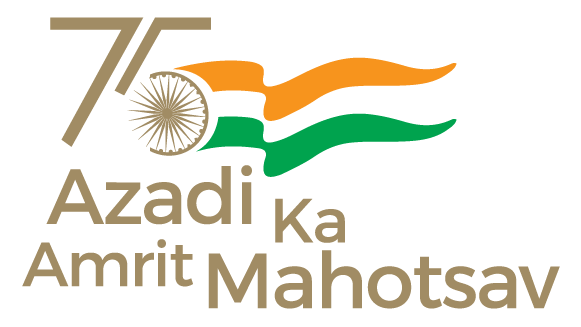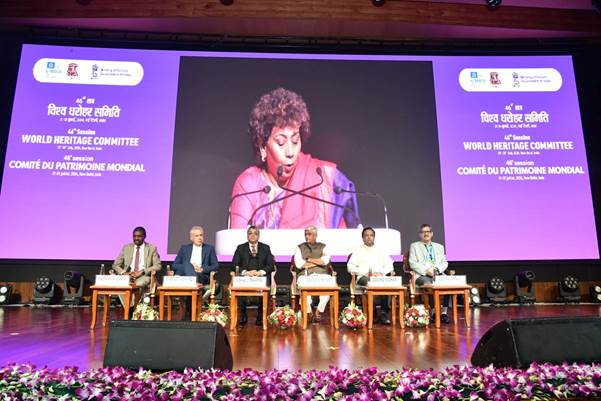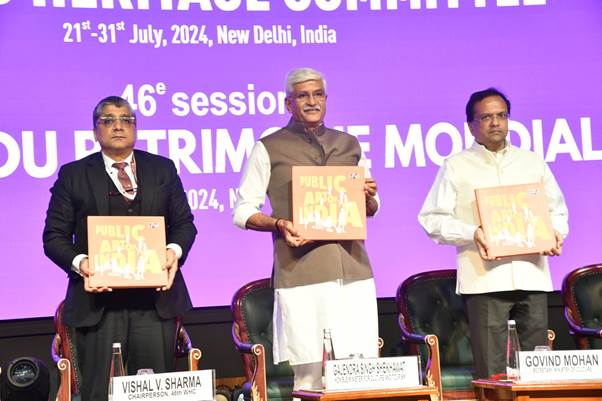
The 46th Session of the World Heritage Committee concluded successfully, marking a significant milestone in global heritage preservation. Held at Bharat Mandapam, this year’s session was a historic event, as it was the first time India has hosted this prestigious international assembly. The closing ceremony was graced by the presence of Union Minister of Culture and Tourism, Shri Gajendra Singh Shekhawat; H.E. Vishal V. Sharma, Chairman, WHC; Mr Lazare Eloundou Assomo, Director, WHC, UNESCO and other key dignitaries.

Minister of Culture and Tourism Shri Gajendra Singh Shekhawat addressed the closing ceremony of the 46th Session. He acknowledged the Ministry of Culture and the Archaeological Survey of India for their swift organization of the event. The Minister also commended the Ministry of Culture for the successful execution of Project PARI (Public Art of India), celebrating India’s public art inspired by its rich heritage. The event witnessed the launch of PARI’s catalogue, showcasing the various artworks and installations put up across the National Capital by various artists from all over the country.

Several exhibitions put-up at the venue mainly for the benefit of the participant. One of the most important was the one displaying various historical objects from different parts of India that were smuggled out of the country… (1/2)#46WHC #46WHCNewDelhi #CultureUnitesAll pic.twitter.com/rge1mICJzb
— Ministry of Culture (@MinOfCultureGoI) July 30, 2024
A dedicated performance from The Shillong Chamber Choir marked the end of the evening.
Here are some highlights from the closing ceremony of the 46th World Heritage Committee at Bharat Mandapam. The evening was truly unforgettable with a stunning performance by the ‘Shillong Chamber Choir’. Enjoy these captivating moments! ✨👇#46WHCNewDelhi #CultureUnitesAll pic.twitter.com/WyHzwTXkUD
— Ministry of Culture (@MinOfCultureGoI) July 30, 2024
46th session of World Heritage Committee
The 46th session of World Heritage Committee was inaugurated by the Prime Minister Shri Narendra Modi, alongside UNESCO Director-General Audrey Azoulay and various other international dignitaries. In his keynote address, Prime Minister Shri Narendra Modi emphasized India’s deep connection to its cultural heritage and its pivotal role in global conservation efforts. He underscored the country’s commitment to protecting and promoting heritage while balancing sustainable development. The Prime Minister’s speech highlighted the theme of “Vikas Bhi Virasat Bhi” (Development and Heritage), advocating for a balanced approach to heritage management that respects the past while supporting future growth.
The Prime Minister also announced several initiatives aimed at enhancing global cooperation in heritage preservation, inviting international delegates to explore India’s rich historical landscape through specially curated tours and exhibitions.
A major highlight of the session was the approval of 24 new sites for inclusion on the World Heritage List. Among these, India’s Moidams-the ancient burial mounds of the Ahom Dynasty in Assam-were recognized for their historical significance. This addition raises India’s total number of World Heritage sites to 43, emphasizing the country’s rich cultural and historical heritage.
The committee also reviewed the state of numerous existing World Heritage sites, focusing particularly on those deemed at risk. Key decisions were made regarding their conservation status and the necessary interventions to ensure their preservation. This reflects the international community’s continued dedication to protecting these invaluable cultural and natural resources.
In addition to the core deliberations, the session addressed various requests for international assistance, highlighting the crucial role of financial and technical support in heritage preservation. India notably pledged $1 million to the UNESCO World Heritage Centre to enhance capacity-building initiatives and support conservation projects in developing countries.
The session featured several forums dedicated to different aspects of heritage management. These included the Young Professionals Forum and the World Heritage Site Managers’ Forum, which provided essential platforms for exchanging knowledge and discussing best practices among emerging professionals and experienced site managers.
Accompanying the main session were cultural exhibitions and side events that showcased India’s diverse heritage. These events included display of repatriated artifacts, traditional crafts, and innovative approaches to heritage preservation, offering delegates a broader perspective on India’s cultural landscape.
More information on 46th WHC:
https://pib.gov.in/PressReleasePage.aspx?PRID=2038168
https://pib.gov.in/PressReleasePage.aspx?PRID=2037604
https://pib.gov.in/PressReleasePage.aspx?PRID=2037495
https://pib.gov.in/PressReleasePage.aspx?PRID=2039130
https://pib.gov.in/PressReleasePage.aspx?PRID=2034693
https://pib.gov.in/PressReleasePage.aspx?PRID=2034457
https://pib.gov.in/PressReleasePage.aspx?PRID=2033506
https://pib.gov.in/PressReleasePage.aspx?PRID=2031567
https://pib.gov.in/PressReleasePage.aspx?PRID=2031268
BeenaYadav



